Lighting might not be everything in photographs or paintings, but it comes close. Where is the main light coming from? What does it highlight? Which colors does it bring out? What shapes are visible that were not before? How do the colors change as the lighting changes?
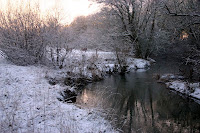
Any pretty scene can end up just a pleasant vacation snapshot, or with wise use of light, it becomes something so exciting it ends up framed and on someone's wall.
The goal of any art is always to do more than replicate a scene but to instead impact the viewer with the 'feeling' of what is being seen. Great art, whether of photographs or paintings, is not in the details but in the emotions.
Paul Cezanne said, "A work of art that does not begin in emotion is not art." I have those words above my desk as a reminder because it fits with writing also. Craft is all very well, but it's passion that is life changing.
For an artist, learning to use light can be a life long challenge. I have seen painters who learn one system of lighting that works and forever after, they replicate it until you know their work each time, and it's so boring, you no longer care.
Where a painter can decide to change the lighting at will (hopefully remembering to keep the source consistent), a photographer has to find the right lighting. It can be enhanced by tools but it cannot totally be created. Some photographers see a scene they like and wait all day or return for the right moment, season or weather. Light often doesn't last long. Lighting needs vary for what is being depicted and the mood the artist wants.
In photography, a polarizing lens is a valuable tool. With an inexpensive polarizing lens, a photo can be turned from so-so to stunning or likewise ruined because a forgotten polarizer dulled or washed out the entire scene.
One morning in January, when I went outside to get some snow photos, the brilliant colors in
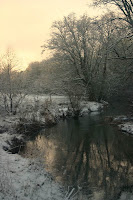 the sky changed my plans. The sunrise was being reflected into the western sky turning it an interesting yellow-orange-- something that seems to happen here mostly in the winter.
the sky changed my plans. The sunrise was being reflected into the western sky turning it an interesting yellow-orange-- something that seems to happen here mostly in the winter.When I walked through the snow down to the creek, I saw something even better as the pale orange sky reflected into the water with a tree perfectly positioned to add more interest.
Moving closer to the bank I wanted to get as much of that yellowish orange as possible. The closer I got to the bank, the better it got and the more I began to wonder where the edge of the bank might have been undercut. My fall would only have been two feet, three at the most, but the icy water is what would make it interesting. I can't-- won't-- count the times I have actually bumped into something or fallen because my eyes were on the possible photograph and not what was under my feet.
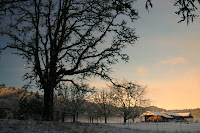
When I felt I had gotten the right shots (digital is such a great tool with how it lets me take so many to get just one), I turned around, and noticed the light and half moon were working with the oak branches (You'll definitely have to enlarge this one to see the moon to the left of the oak).
It was in shooting the moon and trying to get more intensity that I remembered-- polarizing lens-- reflections-- duh! I walked back down to the creek, tweaked the lens. The photos above are within a few minutes of each other; so the main difference is where the polarizing lens was turned and composition.
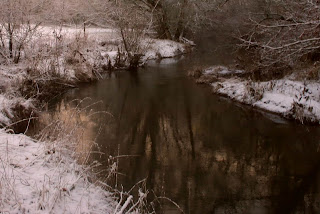 This last photo is cropped for composition, drama, subject, and darkened just a bit with my photo program. These are al the kind of tools that at one time only professional. photographers had as creative options. I personally wouldn't call any of them better than the others-- just different. It's all in what story the photographer wants to tell.
This last photo is cropped for composition, drama, subject, and darkened just a bit with my photo program. These are al the kind of tools that at one time only professional. photographers had as creative options. I personally wouldn't call any of them better than the others-- just different. It's all in what story the photographer wants to tell.
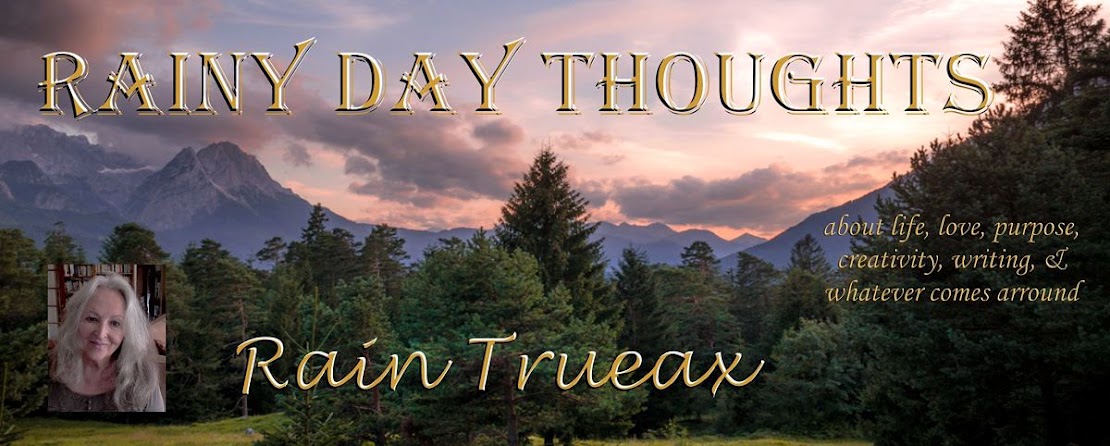
7 comments:
Yes, I also think that photography is primarily painting with light. And digital is wonderful in so many ways but I still sort of miss those hours in the darkroom with film & printing paper. I guess I am still sorting out the digital workflow. But I am loving it!
Your home site is beautiful in the middle of the day but it is magic when you can be their for special moments of light. I hope you will be pleased that I am putting your post as a special link from my blog.
Nice pics Rain !!
Gorgeous photography, Rain.
I'm trying not to be envious of your skill. I am little better than a snapper, and indeed many of my photos were taken with disposable cameras.
I loved all of these and the one with the moon was especially wonderful.
On my blog you commented about Tucson -- is there a Tucson in the Pacific Northwest or do you visit the Southwest as well?
I am glad you all enjoyed the photos from that morning. As Parapluie noted, it's all about being able to be there at the right moment and in this case-- getting lucky
Hey, I thought you were going to be writing about the change of seasons -- that's all about the light for me, too. The temps don't change all that much, but suddenly flowers start to bud and bloom, and my mood picks up as the light lasts longer than 5 pm. But the actual post you made was very instructive and thought-provoking.
Post a Comment